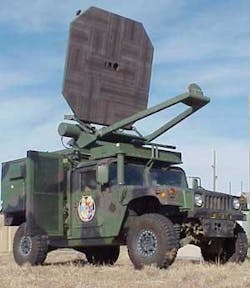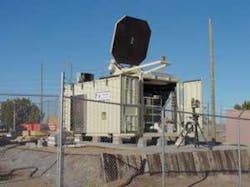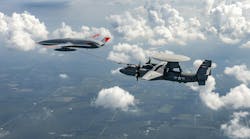By Ben Ames
TUCSON, Ariz. - Researchers with the U.S. Air Force have found a way to deter potential attackers without shooting or otherwise killing or maiming them.
It is called the Active Denial System, a type of nonlethal, directed-energy weapon that focuses millimeter waves on the skin of a suspicious person. The beam causes agonizing pain, but does no lasting damage, they say.
Now Air Force leaders have awarded a $7.5 million contract to Raytheon Missile Systems in Tucson, Ariz., to build a portable version.
Engineers at Raytheon have already built an Active Denial System (ADS) integrated onto a High Mobility Multi Wheeled Vehicle, or HUMV. The company delivered that unit-called System 1-to the Air Force Research Lab at Kirtland Air Force Base, N.M., in fall 2004.
Under the new contract, Raytheon engineers at the company’s Rancho Cucamonga, Calif., facility will build a version of ADS that fits in a portable, armored container. Airmen can load this version-called System 2-onto a flatbed truck or into a C-130 turboprop aircraft for easy transport.
When they arrive, they can use it to protect a strategic location, such as an embassy, detention facility, port, or naval vessel. By comparison, designers built the HUMV-mounted version for battlefield applications, says Alan Fischer, a spokesman for Raytheon Missile Systems. Raytheon is to deliver the new unit by July 2006.
Researchers at the Air Force Research Laboratory originally studied millimeter-wave technology, and staff at the U.S. Department of Defense Joint Nonlethal Weapons Directorate later improved this technology’s application. Together, they have invested $51 million in the project since 1992, according to Air Force records.
The Active Denial System focuses a 95-GHz beam of energy that penetrates a person’s skin less than 1/64th of an inch, producing an instant and painful heating sensation. The system relies on key technologies including a millimeter-wave source, cooling system, and planar-array antenna.
Engineers in the Air Force’s directed-energy directorate are working on many other types of directed-energy weapons for applications from lasers that shoot down missiles to microwave beams that disable electronics.
Because the weapons are based on directed energy-not kinetic energy-they have a unique ability for applications such as force protection, long-range strike, precision engagement, electronic attack, and control of space assets, says Roy Hamil, technical advisor in the laser division of the AFRL’s directed-energy directorate. Hamil made his comments at the Military Technologies Conference, sponsored by Military & Aerospace Electronics, in Boston in March.
The weapons all move at the speed of light, have very deep magazines (as long as they have sufficient electricity), and can deliver a full range of controlled effects, “from deny to destroy.”
They are more than theoretical. As long ago as 1979, troops were testing an airborne laser, he says. Engineers tested adaptive optics in 1990, high-power microwaves in 2002, and lasers for aircraft self-protection in 2004. They are even using them in the field; soldiers used laser dazzlers to dissuade attackers in Somalia in 1989, and a Battlefield Optical Surveillance System (BOSS) in Iraq in 2004.
Other troops are using a nonlethal sound-based system called a directed acoustic device. In December, Army leaders awarded a $4.9 million contract to American Technology Corp. of San Diego for the Long Range Acoustic Device (LRAD). Soldiers in the 3rd Infantry Division are using it in Iraq for crowd control, area denial, and building-clearing.
Army leaders awarded the company another contract for $846,000 in April to order additional LRAD units for the 3rd Armored Cavalry Regiment, also deployed to Iraq.
The LRAD generates a focused beam of sound to issue verbal challenges or instructions to a person more than 500 yards away. If the person does not obey, soldiers can crank up the beam to create a warning tone that is loud enough to dissuade ill intentions.
Sailors on U.S. Navy and Coast Guard vessels use the LRAD in the Persian Gulf to warn small craft to stay away from their vessels, the company says.
Next, designers at American Technology Corp. plan to release a smaller version this summer. The Medium Range Acoustic Device (MRAD) will be about half the size and weight of LRAD, to be optimized for land- and vehicle-based operations such as urban warfare, shorter-range checkpoints and access denial.





